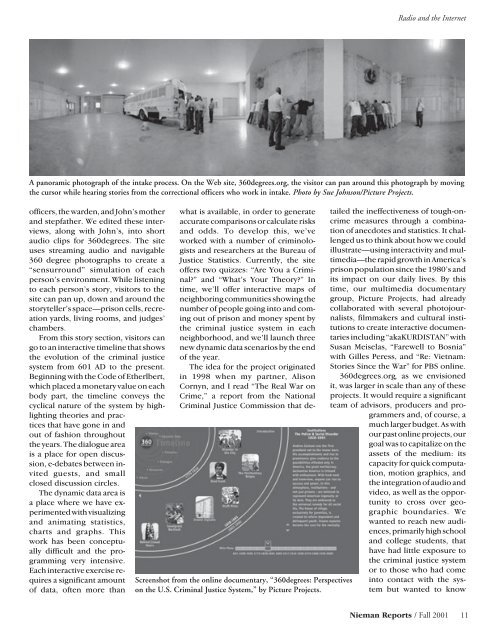Download - Nieman Foundation - Harvard University
Download - Nieman Foundation - Harvard University
Download - Nieman Foundation - Harvard University
You also want an ePaper? Increase the reach of your titles
YUMPU automatically turns print PDFs into web optimized ePapers that Google loves.
Radio and the InternetA panoramic photograph of the intake process. On the Web site, 360degrees.org, the visitor can pan around this photograph by movingthe cursor while hearing stories from the correctional officers who work in intake. Photo by Sue Johnson/Picture Projects.officers, the warden, and John’s motherand stepfather. We edited these interviews,along with John’s, into shortaudio clips for 360degrees. The siteuses streaming audio and navigable360 degree photographs to create a“sensurround” simulation of eachperson’s environment. While listeningto each person’s story, visitors to thesite can pan up, down and around thestoryteller’s space—prison cells, recreationyards, living rooms, and judges’chambers.From this story section, visitors cango to an interactive timeline that showsthe evolution of the criminal justicesystem from 601 AD to the present.Beginning with the Code of Etherlbert,which placed a monetary value on eachbody part, the timeline conveys thecyclical nature of the system by highlightingtheories and practicesthat have gone in andout of fashion throughoutthe years. The dialogue areais a place for open discussion,e-debates between invitedguests, and smallclosed discussion circles.The dynamic data area isa place where we have experimentedwith visualizingand animating statistics,charts and graphs. Thiswork has been conceptuallydifficult and the programmingvery intensive.Each interactive exercise requiresa significant amountof data, often more thanScreenshot from the online documentary, “360degrees: Perspectiveson the U.S. Criminal Justice System,” by Picture Projects.what is available, in order to generateaccurate comparisons or calculate risksand odds. To develop this, we’veworked with a number of criminologistsand researchers at the Bureau ofJustice Statistics. Currently, the siteoffers two quizzes: “Are You a Criminal?”and “What’s Your Theory?” Intime, we’ll offer interactive maps ofneighboring communities showing thenumber of people going into and comingout of prison and money spent bythe criminal justice system in eachneighborhood, and we’ll launch threenew dynamic data scenarios by the endof the year.The idea for the project originatedin 1998 when my partner, AlisonCornyn, and I read “The Real War onCrime,” a report from the NationalCriminal Justice Commission that detailedthe ineffectiveness of tough-oncrimemeasures through a combinationof anecdotes and statistics. It challengedus to think about how we couldillustrate—using interactivity and multimedia—therapid growth in America’sprison population since the 1980’s andits impact on our daily lives. By thistime, our multimedia documentarygroup, Picture Projects, had alreadycollaborated with several photojournalists,filmmakers and cultural institutionsto create interactive documentariesincluding “akaKURDISTAN” withSusan Meiselas, “Farewell to Bosnia”with Gilles Peress, and “Re: Vietnam:Stories Since the War” for PBS online.360degrees.org, as we envisionedit, was larger in scale than any of theseprojects. It would require a significantteam of advisors, producers and programmersand, of course, amuch larger budget. As withour past online projects, ourgoal was to capitalize on theassets of the medium: itscapacity for quick computation,motion graphics, andthe integration of audio andvideo, as well as the opportunityto cross over geographicboundaries. Wewanted to reach new audiences,primarily high schooland college students, thathave had little exposure tothe criminal justice systemor to those who had comeinto contact with the systembut wanted to know<strong>Nieman</strong> Reports / Fall 2001 11
















